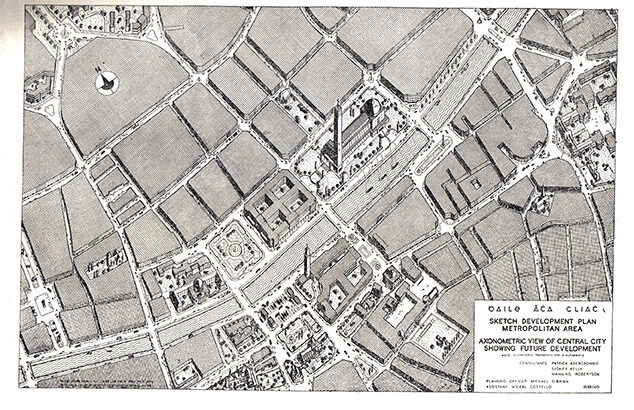In a recent issue some remarks made by the authors of a book on the future of the concept of the parish suggest some confusion about the strange history of Dublin’s cathedrals. I know that many foreign visitors are certainly confused as to why the city has “three cathedrals”.
Of course the older cathedrals, St Patrick’s, which once stood outside the city limit and was of Irish foundation, and of Christ Church Cathedral, founded by the Viking colonists of Dublin, became at the time of the Reformation the property of the Church of Ireland.
Patriotic
This fact over the next centuries rankled with the more pious and patriotic, as can be seen in the forceful, even over forceful remarks of Fr Thomas Corcoran in the Gill’s Guide to Catholic Dublin, issued for the Eucharistic Congress in 1932.
In late Georgian times a movement had got under way to provide the city with a proper Catholic Cathedral to be built hopefully on an open site in the middle of Sackville Street (today’s O’Connell Street), which changing society movements had by then made the heart of the city.
However the penal laws prevented the erection of Catholic churches on any main street, nor could a church be called a cathedral. So instead a “pro-cathedral” was erected in nearby Marlborough Street, and this still remains in use today. But unlike St Patrick’s and Christ Church, the edifice very good though it is, it is rarely visited by tourists. Which is a great pity, for so much of the city’s social, religious and political history is bound up in its classical fabric.
Towards the end of the Victorian era there were many Catholics who urged that the Church of Ireland should surrender either or both of the old Cathedrals to Catholic custody. This, of course, never happened. They carped at the active restoration work done by the Church of Ireland to preserve the fabric of both buildings; but as medieval churches are costly things to maintain, and getting costlier every tear that comes, so it is perhaps as well that this handover never happened. But all three churches are a significant part of the city’s heritage, and one way or another will always need public support and public money.
Real Cathedral
But Catholic feeling for a “real Cathedral” continued to grow. Various schemes were proposed, of which more in a moment. Eventually in the 1930s a site was acquired by the purchase of the private title to Merrion Square park. Here it was proposed to erect a cathedral in full gothic glory facing across the square to Government buildings and the Dáil, placing the Catholic Church at the centre of the public life not just of the city, but the country.
On a technical point: building on land that had once been flowed over by the sea would have presented exactly the same problems that beset the erection of Busárus in the 1950s.
Just before the Great War a plan for Dublin was put forward by Prof. Patrick Abercrombie. This included a scheme for a new Catholic Cathedral. Then followed the destruction of the Revolutionary era, now being celebrated. The urgent task it seemed to both state and city authorities was to get things moving again, to get to work to build up the economy and business again and not to indulge in planners’ pipe-dreams. Nothing was done.
Then again after WWII, when the novelties of city planning were sweeping “Socialist” Britain, ripples of these idea flowed in here too. Abercomie and his associates issued a new report, with a new scheme for Dublin. This too included a vision of a new Cathedral (pictured). It is well worth pondering for it also never came to pass.
But the dreams of the diocese were never to pass either. In the 1950s Dr McQuaid was faced with a real problem, to which all the resources of the diocese had to be reserved. This was the provision of new suburban parish churches for an ever-expanding city, which was filling up rapidly with people from the provinces.
Perhaps today this problem has been solved by the fall in the Catholic population allowing the erection, when really needed, of much smaller edifices rather than the great “Romanesque basilicas” that Dr McQuaid imagined would be necessary.
Spiritual heart of Dublin
I doubt that the Catholic archbishops will ever desert St Mary’s in Marlborough Street. But if there was an urge to move perhaps an older church like St Audeons might better be utilised. Now that would really draw the tourists in when they had done with nearby St Patrick’s and Christ Church, which Google oddly claim’s to be the “spiritual heart of Dublin”, which the Dean down in Kevin Street might gently dispute.


 Peter Costello
Peter Costello Map of the new layout of central Dublin in the Dublin Sketch Development Plan 1939-1940, showing a conception of a new Catholic Cathedral for the junction of Capel Steet with Ormond Quay. Note too the opening up of the vista from the river of Christ Church Cathedral: not a city office in sight!
Map of the new layout of central Dublin in the Dublin Sketch Development Plan 1939-1940, showing a conception of a new Catholic Cathedral for the junction of Capel Steet with Ormond Quay. Note too the opening up of the vista from the river of Christ Church Cathedral: not a city office in sight! 